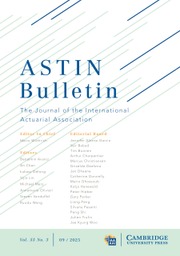No CrossRef data available.
Article contents
Modeling discrete common-shock risks through matrix distributions
Published online by Cambridge University Press: 16 September 2025
Abstract
We introduce a novel class of bivariate common-shock discrete phase-type (CDPH) distributions to describe dependencies in loss modeling, with an emphasis on those induced by common shocks. By constructing two jointly evolving terminating Markov chains that share a common evolution up to a random time corresponding to the common shock component, and then proceed independently, we capture the essential features of risk events influenced by shared and individual-specific factors. We derive explicit expressions for the joint distribution of the termination times and prove various class and distributional properties, facilitating tractable analysis of the risks. Extending this framework, we model random sums where aggregate claims are sums of continuous phase-type random variables with counts determined by these termination times and show that their joint distribution belongs to the multivariate phase-type or matrix-exponential class. We develop estimation procedures for the CDPH distributions using the expectation-maximization algorithm and demonstrate the applicability of our models through simulation studies and an application to bivariate insurance claim frequency data. In particular, the distribution of the latent common shock component present in correlated count data can be estimated as well.
Keywords
Information
- Type
- Research Article
- Information
- Copyright
- © The Author(s), 2025. Published by Cambridge University Press on behalf of The International Actuarial Association

